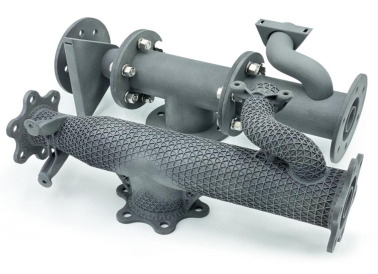When Should I Use Metal 3D Printing?
- cole6447
- Aug 4
- 6 min read
Updated: Sep 4

The above image is property of Rennscot MFG.
Metal 3D printing is a powerful tool, but it’s not the right choice for every part.
Understanding the advantages and disadvantages of Metal AM is essential for engineers and buyers to leverage additive manufacturing to its fullest potential for part design, and supply chain solutions.
Rennscot MFG has years of experience designing and producing metal additive parts, and has learned a great deal about when & where Metal 3D printing is most valuable from this first-hand experience.
The following article outlines key factors to consider when evaluating whether a part is a good fit for additive manufacturing (specifically laser-powder-bed-fusion), with real-world examples to guide decision-makers, inspire creativity, and spark ideas for new use cases.
"The terms Metal 3D printing," "Additive Manufacturing," and "metal AM" may be used synonymously in this article.*
Key Considerations for Additive Manufacturing:
1) Lightweighting
2) Component Consolidation
3) Conformal Cooling & Heating (With Fluid + Gas Routing)
4) Radical Geometries & Design Freedom
5) Low Volume Casting & Forging Replacement
1) Lightweighting
Metal AM is a layer by layer manufacturing methodology. As such, it’s possible to produce parts that are hollow inside, or even contain internal structures.
While these features cannot be machined, 3D printing is able to fabricate them “in-situ” within a component and “seal” the part as the build continues, permanently locking the internal structure away from the world.
A cut-open cross section showing the inside of a part that’s been filled with Light-Weight lattice structure. This design is both stronger, and lighter than the legacy design it replaces. Above images are property of Rennscot MFG.
All of the use cases for these internal structures are yet to be uncovered, but our customers currently find them to be very useful for shedding weight, improving heat dissipation, and creating passages for fluids/gasses. More on those use cases later in the article.
2) Component Consolidation
Fabricating a multi-piece assembly as one “printed” component eliminates BOM items, discrete manufacturing processes, reduces QC inspection operations, eliminates many failure modes, and produces a part that offers better performance. As a result the value-to-cost ratio can be greatly increased.
An assembly that traditionally contains 3 cast components, 2 welds, and 24 pieces of hardware can be reduced to one part when taking advantage of the strengths of 3D printing. Image Source: nTop. Learn more from their video here.
In large military programs, consolidating BOMs by 30% can drive huge cost savings, eliminating many unique SKUs that government contractors must manage through Life Cycle Sustainment (LCS).
In some cases, the cost per part can be greater with AM components, but even in these cases the value is often far greater. The parts may perform better at dissipating heat, or flowing fluid smoother thanks to the lack of seams, but most importantly they can be far more reliable. Taking a multi-piece assembly and turning it into one homogenous material can mitigate failure modes related to hardware and high temperature applications where incongruent thermal growth coefficients can lead to leaks and ruptures. This is yet another way in which additive manufacturing brings considerable value.
3) Conformal Heating + Cooling with Internal Routing
As previously mentioned, metal additive manufacturing can produce features within walls of components. This becomes an incredibly useful tool when trying to pass fluids through an assembly, or attempting to cool an important system while minimizing joints. For example, if cooling fluid and lubrication is required for an avionics system it would traditionally be conveyed via external tubes adding weight and external hardware to a design. The printing process allows engineers to incorporate channels within the body of the part.
Printing channels inside of the dead space of the part for conveying process fluids and gases utilizes dead space more effectively and eliminates the need to run external cooling/fluid lines. This helps improve process and part performance by:
Simplifying and/or eliminating manufacturing and assembly steps
Reducing BOM items
Reducing material input and final piece weight
Allowing for more intricate part designs vs traditional subtractive and brazing techniques
Broadening part functionality and use cases
For example, if cooling fluid and lubrication is required for an avionics system - traditionally conveyed via external tubes adding weight and external hardware to a design - the printing process allows engineers to incorporate channels within the body of the part. Above images are property of Rennscot MFG.
One of the most exciting advantages of metal additive manufacturing is the ability to create complex internal geometries that were previously impossible to machine.
Because parts are built by incredibly accurate material addition, engineers can now design internal channels that route fluids and gases in three dimensions, not just in “straight, round holes” as with traditional drilling.

Note the cross-section shape of these cooling channels… this custom shaped cooling passage perfectly conforms to the external surface it is cooling… this is impossible with CNC machining – “holes must be round and straight, because drill bits are round and straight” – but easily achieved with Metal 3D Printing. Image source: Imperial Machine.
This opens the door to performance-enhancing features like conformal cooling, where the cross-sectional shape of an internal passage mirrors the contours of the surface being heated or cooled.
Unlike conventional round cooling passages, which offer only a single point of tangency for heat transfer, conformally-shaped cooling channels provide greater surface area and more uniform thermal interaction.
Additive manufacturing also enables ultra-thin walls, and variable porosity, which combine to make the heat exchangers of the future possible today.
4) Radical Geometries & Design Freedom
Additive manufacturing is simply nothing like the manufacturing methods of the past. Designers, engineers, and AI programs have just scratched the surface of the forms that we can create with metal thanks to laser powder bed fusion.
This hollow sphere can rotate freely… yet is 100% captured within the metal frame around it. It can only be made via additive manufacturing, thanks to it’s layer-by-layer fabrication method. Above images are property of Rennscot MFG.
These capabilities are not just enhancements; they represent a fundamental shift in what’s possible. The fusion of AM machine architecture with “design-for-additive” thinking enables radical design freedom, inspiring a new generation of components optimized not just for how they’re made, but for how they perform.
Open your mind to these new alien shapes. If you can model it with some basic printing requirements in mind, metal 3D printing can play a part in creating it.
5) Low Volume Casting & Forging Replacements
Sometimes, the value of metal additive manufacturing extends well beyond its core design advantages. Printed parts can be post-processed to meet demanding mechanical requirements, including heat treatment and hot isostatic pressing, resulting in properties comparable to cast or forged components.
Because metal AM is a highly controlled, repeatable process that requires no tooling or molds it excels in situations where design flexibility, speed to market, and low-volume production are critical.
Any number of part variations can be produced from the same machine, making metal AM an ideal alternative when casting and forging lead times are long or minimum order quantities are high.
While 3D printing may not be as cost-effective for mass-producing castable parts, it does become a compelling choice when only a few parts are needed, or when tooling is unavailable or uneconomical to produce.
As defense and aerospace programs seek faster, more agile manufacturing methods, Metal AM is poised to become a cornerstone technology for the decades ahead.
With traditional castings, production often takes months, or even over a year, due to tooling lead times, pattern making, and foundry backlogs. In contrast, Metal AM begins with a digital file. As soon as a 3D model is finalized, printing can start – often within hours. This tool-less approach enables incredibly fast turnaround, especially in urgent or low-quantity scenarios.

In one recent case, military program managers faced an 18-month wait for a replacement casting due to limited foundry capacity. Using metal AM, the first functional part was delivered in under two weeks! Image source: Britannica
For defense and aerospace applications, this blend of speed, flexibility, and performance makes Metal AM an increasingly vital solution to supply chain constraints.
Conclusion
Metal additive manufacturing is not a one-size-fits-all solution. But, when applied thoughtfully it can unlock performance, flexibility, and speed that traditional methods can’t match. Whether it’s enabling advanced thermal management, accelerating lead times, or producing geometries that were once impossible, metal AM offers powerful advantages for the right applications. The key is knowing when to use it. By understanding its capabilities and constraints, engineers and buyers can make smarter decisions and turn additive manufacturing from a niche tool into a strategic asset.
Rennscot MFG continues to refine its additive manufacturing capabilities, and our team helps customers evaluate where Metal AM adds the most value by turning complex challenges into production-ready solutions. Our Design and Applications Engineers are ready to support your product design process through Design for Additive Manufacturing (DFAM). To learn more or explore whether your part is a good fit for additive manufacturing, reach out to our team!
Look out for our next published post that will dive deep into a thermal management solution in development that can be applied across industries.



















